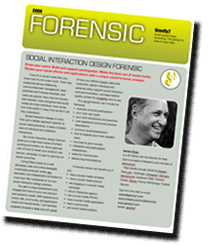For the past month, besides working on my two contracting gigs, I've been reviewing research in a number of fields. Getting
theoretical distance from social software by backing up the value chain. Network relations theory, media ecology, cultural anthropology, economics, ethnography, ethnomethodology, Simmel's sociology, cybernetics, systems theory. And I just found sociocybernetics, an admixture of
Luhmann's auto-poetic social systems theory and the humanist strain in German sociology still headed up by Habermas. I've always found that new thoughts are best recognized askew, lit from an angle, glanced askance. And so when I feel stuck, as I have recently with my pursuit of
Social Interaction Design (SxD), I spread myself out.
The Link. What a strange thing it is. I'll do more on this soon, but here's just a sampling of what makes the link so strange:
Linguistics:
It is often a statement, a word, phrase, or sentence written first and then selected and given a target url. For this, the link has linguistic meaning. As speech or writing, it can be read by users for what it says. Semantics, expression, and syntax matter.
Graphical Design:
The link is presented in a typeface, with color and size drawing attention to it. Underlined blue links are common convention. Underlined text is a common convention. Links in bold, big and red and near the top of the page attract attention for visual reasons. Presentation matter.
Contextuality:
Links appear in context. A top ten list; a tag cloud; a headline; an author's name. The contextual use of a link corresponds to its value/meaning.
Dynamically updated:
Links may reflect server logs and site/system use. Links for example that reflect popularity: the more they're clicked, the more popular their designation (person, product, url, etc.). A link's meaning may dynamically reflect usage.
Navigation:
Links go somewhere; they're navigation required if the user is going to be able to leave the page s/he's currently on. As such, they select from information and lead to information. They are limiting and also enabling. Words that lead to more, they can be static or dynamic, can use the conventions of site navigation, etc.
Action system:
Links go somewhere. They are a selection from possibilities, are a choice that produces a next page, that next page then also having its links, and so on and so forth. We call this an action system, insofar as selection upon selection correspond to the user's agency (actor: actions) over time, each choice (click) by the user both constraining and enabling what happens next.
Social:
Links sometimes correspond to social phenomena: attention, interest, social relation (friends, colleagues, employees, family), celebrity, popularity, etc. Links can articulate a question or appeal directed at somebody (in a discussion, or social software site). Or they might correspond to a response. What matters is that they can be the expression of social meanings when the site or application supports interaction and communication.
Technorati tags:
social software,
interaction design,
UI,
web 2.0,
web design



